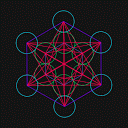The Tree of Life, the kabbalah’s model and teaching tool, is a map for evolving consciousness. It is an overview of the interconnected energy pathways we walk on the human journey of spiritual beings.
In the language of metaphor, from No-thing-ness (Ein Sof) the Oneness that was, is and shall be, without beginning or end, without time or place, appears a spark of light that expands into a beam (Ein Sof Or) that cleaves the veils of chaotic darkness, as a structure and order are introduced in ten consecutive and simultaneous stages. This cosmic design provides pods of ‘cosmic chakras’ and paths that connect them, providing the possibility of diversity in unity and the polarities which makes choice possible, as well as the central path of balance that harmonizes the opposites. We ponder the mysteries of life— where we are, why we are here and where we are headed. Formed in the image of a creative Divinity, we are creative beings with magical powers.
The Tree of Life can be applied to many fields of study. Here, we consider the creative process involved in an author bringing a book into being. The same process can be seen in any creative field. Seemingly from nowhere comes the inspiration to create something new. Is it a feeling? A knowingness? On the canvas, the painter brings light to contrast with the dark and the dancer offers movement to disturb the stillness. The process begins, the final product unknown.

The Creative Process
1 Spark/Crown (Keter)
Seemingly from nowhere comes the spark of a fleeting thought/image. It is magical and mysterious and we do not have the vocabulary to describe these early stages this more clearly.
2 Wisdom (Chochmah)
Becoming aware of this fleeting impression and its potential, the spark expands in the mind and many ideas are generated.
3 Understanding (Binah)
In the pregnant pause that follows, a design/plan takes shape — what is possible? A plan starts to form?
4 Compassion (Chesed)
The author simultaneous examines how he/she feels about the possible characters and scenarios that will be experienced as many iterations are considered and sense of excitement and enthusiasm is generated in the author.
5 Strength/Severity (Gevurah)
Not everything can be contained in a single work— some relationships, some characters need to be eliminated to bring clarity to the significant story that will be told.
6 Harmony/Beauty (Tiferet)
As ideas and images converge, as possibilities are refined and a structure that feels right emerges, there is a sense of well-being as an exciting structure starts to form.
7 Innovation/Victory (Netzach)
The actual work beings as the author starts to write— new ideas, new words and sentences expressing the images and relationships he/she had in mind begin to ‘write themselves’ sharing this personal expression of creativity.
8 Tradition/Splendor (Hod)
The work is passed into the sphere of production where editing and re-editing is done to refine the story and its expression, making the work understandable for others in the best way possible.
9 Imagery/Foundation (Yesod)
The manuscript now flows into a galley, forming the book, physical (or electronic) that will not only be interesting to read, but in physical form, will feel good in the hands and bring visual pleasure to the readers, enhancing the storytelling ability of the writer.
10 Physicality/Kingdom (Malchut)
The publication arrives in the hands of the writer and the public and a personal vision is shared with the world.
